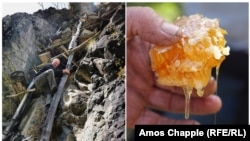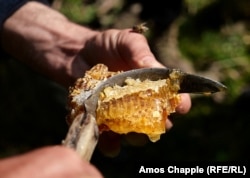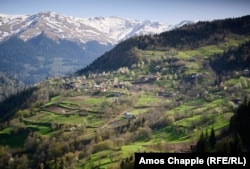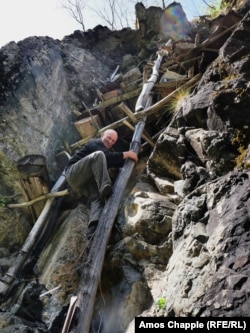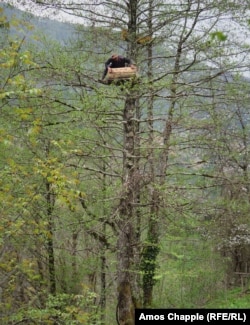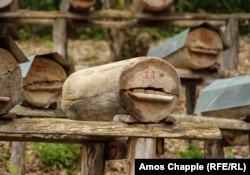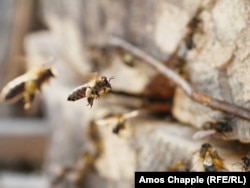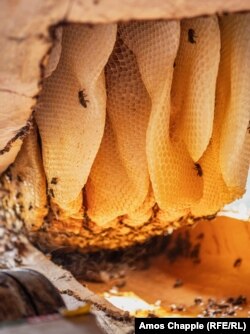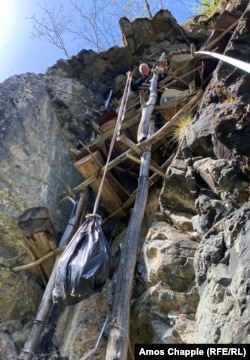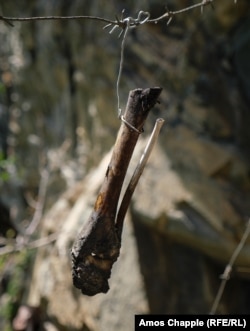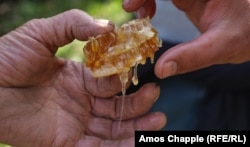The beekeepers of western Georgia who risk their lives for liquid gold
This is jara honey, one of the purest natural treats on Earth.
It is made only in the mountains of Ajara, in western Georgia.
Each spring and autumn when the weather is mild and stable, Ajaran beekeepers near Georgia’s border with Turkey scale cliffs…
…and climb tall trees to harvest honey using a technique so ancient its origins are lost to time.
Jara beehives are made by hollowing out linden trees, which are favored for their lightweight and easily workable timber.
The logs are then placed where bees can discover them, usually deep in the forest. Carved logs are nearly identical to wild bees’ natural habitat of hollow tree trunks.
Bees inside the jara logs create their own honeycombs from scratch, unlike the more hands-on box hives in which many beekeepers use sheets of artificially shaped wax combs for the bees to work with.
The Caucasian Mountain Gray honeybees that produce jara honey are coveted around the world for their hardiness in cold weather and their long tongues that slurp up scraps of nectar missed by other species. The bees are relatively docile, but their stings feel unusually painful.
Some jara beekeepers keep their hives close to their homes where they can easily be protected.
Other beekeepers go to extraordinary heights to keep their hives out of reach of the honey-hungry bears that roam the Ajaran highlands.
Ramaz Dumbadze -- seen checking on a hive about 16 meters high -- keeps 26 jara hives in the forest around his home. The agile 44-year-old says, “I think there is something special about the hive hanging in the tree. It is like a separate kingdom where only bees reign.”
He says income from his jara honey has helped him renovate his house, which is a short walk from this tree.
As well as eating the fresh honey, some Ajaran villagers brew this fiery but smooth honey liquor from their harvests. It is estimated that around 6 tons of jara honey are produced each year, up from just 2 to 3 tons before 2017. Around eighty beekeepers are currently active.
Tamaz Putkaradze harvests his jara hives from a rickety framework of wood and wire that he built some 20 years ago in the crevice of a cliff.
The 69-year-old says he has been “fascinated” by the jara beekeeping method since he was a small boy watching his father hacking hives into shape and working carefully with his dad's bees. Putkaradze has taught his own adult son, seen in the white T-shirt, the same techniques.
Inside one of Putkaradze’s 20 hives, honeycombs hang from the top of the hollow log. He says he's been working with bees all his life largely to “keep the tradition alive,” but thanks to the growing market for the unique honey he plans to add 10 more hives to his forest portfolio.
To harvest his honey, Putkaradze uses a curved blade (seen in first photo) to carefully slice honeycombs from the roof of the hive. The sweet treasure then flops onto his hand like a syrup-drenched pancake.
Putkaradze lowers a bag of the delicate harvest to his son, who is waiting below with a bucket to carry the honeycombs down the mountain. The harvest takes place only once each year.
As well as installing his beehives above the reach of bears, Putkaradze has also made a witchy perimeter fence of clanging, Soviet-era metal scraps and bear bones (pictured) to spook the sweet-toothed animals.
Putkaradze shares a chunk of honeycomb from his cliff-top harvest. The honey is clear, slightly fruity, and thrilling to eat with a handful of cold mountain stream water to wash it down.
The elderly beekeeper is delighted the unique honey is seeing a small but growing level of interest from outside Georgia: “I have been following this journey for decades now…. I believe bees are important for keeping our beautiful nature alive, and jara beekeeping allows me to play my part in this.”
